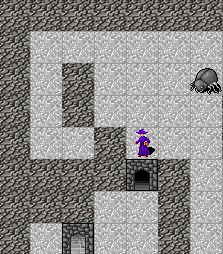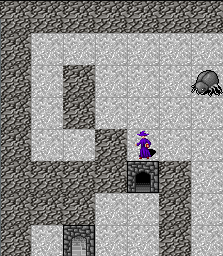Haskell roguelike - Layers
Something wrong
If you move the player over an open door, you may notice that something is not quite right.

When the player is at the same position as the door, the door disappears. Whats interesting is that this does not happen to the background tiles.
Looking at the tile for the player  , you can see that it has a transparent background. The UI drawing logic first draws the background tiles and then draws whatever tile we tell it to on top of that. When the player is on a blank tile you then get the player drawn with the background showing through. But when the player is on the door, then the current drawing logic replaces the door entity with the actor entity and so only the player’s tile is show.
, you can see that it has a transparent background. The UI drawing logic first draws the background tiles and then draws whatever tile we tell it to on top of that. When the player is on a blank tile you then get the player drawn with the background showing through. But when the player is on the door, then the current drawing logic replaces the door entity with the actor entity and so only the player’s tile is show.
However it is clear that the UI supports layering of images, so lets make use of this fact.
Layers
Rather than sending a single set of entities to draw, lets send an array of layers. So change drMapData from a [(Int, Int, Int)] to a [[(Int, Int, Int)]]. I.e. from an list of positions to an array (layers) of list of positions.
08_layers/src/GameCore.hs (88 to 92)
data UiDrawCommand = UiDrawCommand
{ drCmd :: !Text
, drScreenWidth :: !Int
, drMapData :: ![[(Int, Int, Int)]]
} deriving (Generic)Then the UI draws each layer in order, i.e. the first layer is at the bottom the last is the top. This is achieved by adding a loop over the layers list and the drawing each layer as we did before.
08_layers/html/rogue.js (115 to 135)
case "draw": {
config.drawId = Math.random();
const colWidth = cmd.screenWidth;
const ctx = document.getElementById("tilesCanvas").getContext("2d");
//Draw background image of blank tiles
ctx.drawImage( getCachedBlankCanvas(), 0, 0 );
R.forEach( layer => {
R.forEach( ([atX, atY, tid]) => {
const [tX, tY] = tileFromTileId( tid );
//function drawTile( ctx, img, twidth, theight, dx, dy, trow, tcol ){
drawTile( ctx, tilesMain, config.tileWidth, config.tileHeight, atX, atY, tX, tY );
}, layer )
}, cmd.mapData );
break;
}drawAndSend
drawAndSend is changed to return an array of layers. I.e. from
to
<<$>> is Protolude’s infix for (fmap . fmap). So here each layer is converted to a list, and then mkDrawMapData is called for each (PlayerPos, Tile) in each list.
08_layers/src/GameEngine.hs (211 to 223)
drawAndSend :: World -> IO ()
drawAndSend world = do
let layers = drawTilesForPlayer world (world ^. wdMap)
let cmd = Ae.encodeText UiDrawCommand { drCmd = "draw"
, drScreenWidth = world ^. wdPlayer ^. plScreenSize ^. _1
, drMapData = mkDrawMapData <<$>> (Map.toList <$> layers)
}
sendData (world ^. wdPlayer ^. plConn) cmd
where
mkDrawMapData :: (PlayerPos, Tile) -> (Int, Int, Int)
mkDrawMapData (PlayerPos (x, y), tile) = (x, y, tile ^. tlId)drawTileForPlayer
drawTilesForPlayer does the work of creating the layers
08_layers/src/GameEngine.hs (262 to 303)
drawTilesForPlayer :: World -> Map WorldPos Entity -> [Map PlayerPos Tile]
drawTilesForPlayer world entityMap =
let
-- Entity base layer
entityLayer = mkLayer entityMap
-- Actor layer on top
actorMap = Map.fromList $ (\a -> (a ^. acWorldPos, a ^. acEntity)) <$> getAllActors world
visibleActorMap = Map.filterWithKey inView actorMap
actorLayer = mkLayer visibleActorMap
in
[entityLayer, actorLayer]
where
player = world ^. wdPlayer
-- Top left of player's grid
(WorldPos (topX, topY)) = player ^. plWorldTopLeft
-- Players screen/grid dimensions
(screenX, screenY) = player ^. plScreenSize
-- Bottom right corner
(bottomX, bottomY) = (topX + screenX, topY - screenY)
inView (WorldPos (x, y)) _ =
x >= topX && x < bottomX && y > bottomY && y <= topY
mkLayer :: Map WorldPos Entity -> Map PlayerPos Tile
mkLayer entities =
let
-- Filter out blank
noEmptyMap = Map.filter (\e -> e ^. enTile ^. tlName /= "blank") entities
-- Only get the entitys that are at positions on the player's screen
visibleEntitys = Map.filterWithKey inView noEmptyMap
-- Get the tile for each entity
tileMap = (^. enTile) <$> visibleEntitys
in
-- Get it with player positions
Map.mapKeys (worldCoordToPlayer $ player ^. plWorldTopLeft) tileMapTo fix the issues only two layers are required. The bottom layer has the entities, and the top layer has the actors. The code for getting entities remains pretty much the same as before. The code for the actors is changed to create a separate layer for them.
08_layers/src/GameEngine.hs (265 to 274)
let
-- Entity base layer
entityLayer = mkLayer entityMap
-- Actor layer on top
actorMap = Map.fromList $ (\a -> (a ^. acWorldPos, a ^. acEntity)) <$> getAllActors world
visibleActorMap = Map.filterWithKey inView actorMap
actorLayer = mkLayer visibleActorMap
in
[entityLayer, actorLayer]And it works

Chapters
Changes
src/GameCore.hs
diff -w -B -a -d -u -b --new-file 07_collisions/src/GameCore.hs 08_layers/src/GameCore.hs
--- 07_collisions/src/GameCore.hs
+++ 08_layers/src/GameCore.hs
@@ -86,10 +84,11 @@
deriving (Generic)
+
data UiDrawCommand = UiDrawCommand
{ drCmd :: !Text
, drScreenWidth :: !Int
- , drMapData :: ![(Int, Int, Int)]
+ , drMapData :: ![[(Int, Int, Int)]]
} deriving (Generic)
html/rogue.js
diff -w -B -a -d -u -b --new-file 07_collisions/src/GameEngine.hs 08_layers/src/GameEngine.hs
--- 07_collisions/src/GameEngine.hs
+++ 08_layers/src/GameEngine.hs
@@ -210,13 +207,14 @@
pure (x, y)
+
drawAndSend :: World -> IO ()
drawAndSend world = do
- let playerTiles = drawTilesForPlayer world (world ^. wdMap)
+ let layers = drawTilesForPlayer world (world ^. wdMap)
let cmd = Ae.encodeText UiDrawCommand { drCmd = "draw"
, drScreenWidth = world ^. wdPlayer ^. plScreenSize ^. _1
- , drMapData = mkDrawMapData <$> Map.toList playerTiles
+ , drMapData = mkDrawMapData <<$>> (Map.toList <$> layers)
}
sendData (world ^. wdPlayer ^. plConn) cmd
@@ -259,9 +258,23 @@
PlayerPos (worldX - worldTopX, -(worldY - worldTopY))
-drawTilesForPlayer :: World -> Map WorldPos Entity -> Map PlayerPos Tile
+
+drawTilesForPlayer :: World -> Map WorldPos Entity -> [Map PlayerPos Tile]
drawTilesForPlayer world entityMap =
+
let
+ -- Entity base layer
+ entityLayer = mkLayer entityMap
+
+ -- Actor layer on top
+ actorMap = Map.fromList $ (\a -> (a ^. acWorldPos, a ^. acEntity)) <$> getAllActors world
+ visibleActorMap = Map.filterWithKey inView actorMap
+ actorLayer = mkLayer visibleActorMap
+ in
+ [entityLayer, actorLayer]
+
+
+ where
player = world ^. wdPlayer
-- Top left of player's grid
@@ -273,22 +286,17 @@
-- Bottom right corner
(bottomX, bottomY) = (topX + screenX, topY - screenY)
- -- Filter out blank
- noEmptyMap = Map.filter (\e -> e ^. enTile ^. tlName /= "blank") entityMap
+ inView (WorldPos (x, y)) _ =
+ x >= topX && x < bottomX && y > bottomY && y <= topY
- -- Add the actors to the map.
- -- Notice that this will replace whatever entity was there (for this draw)
- -- This fold works by
- -- - Starting with the map of entities that are not blank
- -- - Inserting each actor into the updated map (the accumulator)
- -- getAllActors is called to get the player's actor and all other actors
- noEmptyMapWithActors = foldr
- (\actor accum -> Map.insert (actor ^. acWorldPos) (actor ^. acEntity) accum)
- noEmptyMap
- (getAllActors world)
+ mkLayer :: Map WorldPos Entity -> Map PlayerPos Tile
+ mkLayer entities =
+ let
+ -- Filter out blank
+ noEmptyMap = Map.filter (\e -> e ^. enTile ^. tlName /= "blank") entities
-- Only get the entitys that are at positions on the player's screen
- visibleEntitys = Map.filterWithKey (inView topX topY bottomX bottomY) noEmptyMapWithActors
+ visibleEntitys = Map.filterWithKey inView noEmptyMap
-- Get the tile for each entity
tileMap = (^. enTile) <$> visibleEntitys
@@ -296,10 +304,6 @@
-- Get it with player positions
Map.mapKeys (worldCoordToPlayer $ player ^. plWorldTopLeft) tileMap
- where
- inView topX topY bottomX bottomY (WorldPos (x, y)) _ =
- x >= topX && x < bottomX && y > bottomY && y <= topY
-
getAllActors :: World -> [Actor]
getAllActors world =
--- 07_collisions/html/rogue.js
+++ 08_layers/html/rogue.js
@@ -120,12 +121,14 @@
//Draw background image of blank tiles
ctx.drawImage( getCachedBlankCanvas(), 0, 0 );
+ R.forEach( layer => {
R.forEach( ([atX, atY, tid]) => {
const [tX, tY] = tileFromTileId( tid );
//function drawTile( ctx, img, twidth, theight, dx, dy, trow, tcol ){
drawTile( ctx, tilesMain, config.tileWidth, config.tileHeight, atX, atY, tX, tY );
+ }, layer )
}, cmd.mapData );
break;